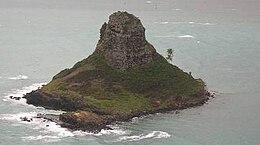Mokolii
 |
|
| Geography | |
|---|---|
| Location | Oahu, Hawaii |
| Coordinates | 21°30′33″N 157°49′47″W / 21.5092°N 157.8297°WCoordinates: 21°30′33″N 157°49′47″W / 21.5092°N 157.8297°W |
| Area | 12.5 acres (5.1 ha) |
| Highest elevation | 206 ft (62.8 m) |
| Administration | |
|
United States
|
|
Mokoliʻi, commonly known as Chinaman's Hat, is a basalt islet in Kāneʻohe Bay, Hawaii. Mokoliʻi is part of Kualoa Regional Park and located 1⁄3 mile (0.54 km) offshore of Kualoa Point, Oahu. The 12.5-acre (5.1 ha) islet was at one time part of a basaltic ridge on Oahu before marine erosion separated it.
Mokoliʻi translates from Hawaiian as "little lizard." According to Hawaiian mythology, the island is the remains of a giant lizard's or dragon's tail that was chopped off and tossed into the ocean by the goddess Hiʻiaka. (Note there are no lizards native to Hawaii.) The common name of Chinaman's Hat derives from its likeness to the Asian conical hat.
Both wildlife and plants of Mokolii have been affected by the presence of non-native species, in particular the black rat and yellow crazy ant. Although other species of birds previously nested there, the Wedge-tailed shearwater is the only species of bird that nests on Mokolii. 72 species of plants have been identified, the majority of which are invasive non-native species. Native plants thrive in the coastal margins and include ahu awa (Cyperus javanicus), naupaka (Scaevola taccada), and ilima (Sida fallax). Invasive plants which dominate the slopes are Lantana camara, Spanish needles (Bidens alba var. radiata), and christmasberry. The island was designated as a critical habitat for Carter’s panicgrass (Panicum fauriei var. carteri) by the U.S. Fish and Wildlife Service (USFWS) in 1983. In 2002, the USFWS initiated a program to eradicate rats from Mokolii.
...
Wikipedia
